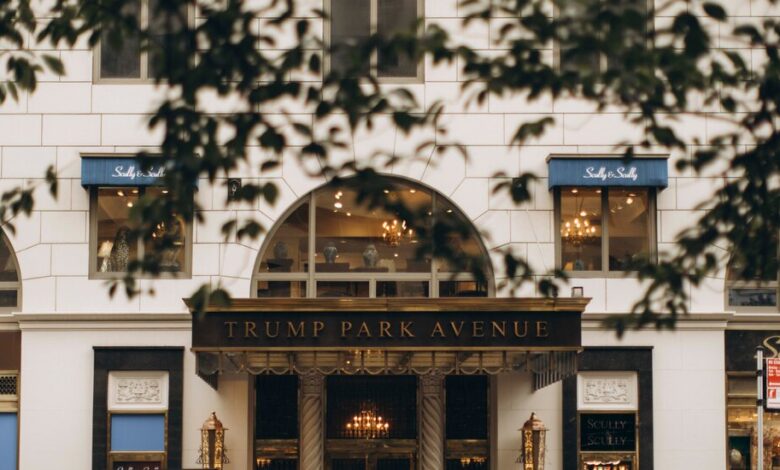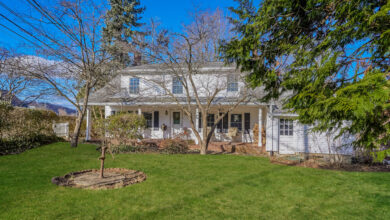In New York, the Trump Brand Is Costing Some Condo Owners

[ad_1]
In the world of real estate, Donald J. Trump’s name has long been synonymous with luxury. At one of his buildings in Manhattan, a five-story waterfall slides down a wall of Breccia Perniche marble. White-gloved doormen, cascading chandeliers and panoramic views of the city’s skyline are the hallmarks of another.
It’s that image of luxury, which he turned into a brand, that the former president held up as a rebuttal to the recent lawsuit that he lost on Friday after a judge determined that Mr. Trump fraudulently inflated the value of his real estate holdings, ordering him to pay a penalty that will exceed $450 million.
“My client is worth hundreds and hundreds of millions,” said one of Mr. Trump’s lawyers, Alina Habba, during closing arguments at the trial, adding, “let alone the brand, which is worth billions.”
But up and down the spine of Manhattan, condominiums in high-rise buildings emblazoned with Mr. Trump’s name have underperformed, according to sales data from two real estate tracking firms, and an analysis of the data by the Columbia University economist Stijn Van Nieuwerburgh.
The line in the sand is the year 2016, when Mr. Trump was elected president.
In a one-year window, condos in buildings that had the Trump logo went from selling at a 1 percent premium compared with similar units, to selling for 4 percent less, meaning that Trump condos became a “bargain” among the city’s luxury units, said Mr. Van Nieuwerburgh, a professor of real estate.
Even the Trump Tower on Fifth Avenue, one of the crowning achievements of the Trump brand, whose 80-foot cascade flowing down a wall of peach marble was reportedly built with slabs handpicked at a quarry in Italy by Mr. Trump’s ex-wife, saw the average price per square foot of its condominiums tumble 49 percent since 2013, according to Ondel Hylton, the senior director of content and research at CityRealty. The building’s age, growing competition from the ultra-luxurious condos on nearby Billionaires’ Row and regular protests have all dampened interest, Mr. Hylton said.
By contrast, condominiums in four buildings where the Trump logo was removed at the behest of residents — sometimes after a legal battle — have seen their value shoot back up.
“This analysis cleanly identifies that it is the Trump brand that is responsible for the value deterioration,” Mr. Van Nieuwerburgh said. “Removing the Trump name from the building removes the loss associated with the name.”
A review of the price per square foot of condominiums in the seven buildings in Manhattan that still carry the Trump name found that the value dropped 23 percent between 2013 and 2023, according to CityRealty, a real estate listing website. An analysis using a slightly different methodology by ATTOM, a property data analytics company, showed that the drop was 17 percent.
By contrast, the four buildings that removed the gold-hued Trump logo ended the decade from 2013 to 2023 up 9 percent, outpacing the Manhattan condominium market, which was up 8 percent over the same time period, according to City Realty.
Mr. Van Nieuwerburgh started with the same data, then combed through the sales figures, making sure that he was comparing apples to apples: a three-bedroom condo in a doorman-serviced Trump building on the Upper West Side, for example, was compared to a three-bedroom unit in the same neighborhood in a building that also had a doorman.
He found that the Trump-branded buildings collapsed in value by 25 percent compared with similar properties from their peak in 2013. “It’s huge,” he said.
The data that was analyzed is exclusively for Manhattan. It is possible that Mr. Trump’s brand is faring better in parts of the country where the former president’s politics are more aligned with a majority of voters, including in Florida, which is home to his Mar-a-Lago resort, as well as numerous towers in Sunny Isles Beach and Hollywood, Fla., that are adorned with his name.
In an email, Eric Trump, the former president’s son and the de facto chief executive of the Trump Organization, questioned the analyses.
“Data can be manipulated to tell any story you want, but the fact remains that our buildings sell for the highest prices per square foot of any properties in the world. That is undeniable,” he wrote. “This year alone, Trump International Hotel & Tower New York closed on a $17 million unit, exceeding the prices at Time Warner, Essex House and the most prestigious properties in the city.”
But the $17 million condo sale at 1 Central Park West, also known as the Trump International Hotel, is a far cry from the top-selling condos in the city, which included a $52 million sale for a West Village penthouse. The Trump condo sold for over $4,600 per square foot; the penthouse sold for more than $11,400 per square foot, according to CityRealty.
A review of the top 100 sales in 2023 found that the best-selling condo in a Trump-branded building placed No. 47 on the list, while the second-best-selling unit placed No. 77, CityRealty found.
“I just crunched the numbers in the past half hour, and I’m still trying to wrap my head around it,” said Mr. Hylton, CityRealty’s senior director of content and research, who expressed surprise at how much value Trump-branded condos had lost.
Defining ‘Most Expensive’
Even Mr. Trump’s critics say he deserves credit for the way he has parlayed family wealth, boldly expanding his father’s empire from a portfolio that included thousands of mostly working-class apartments in the outer boroughs into the heart of Manhattan.
In the 1970s, when even the Chrysler Building was in foreclosure, Mr. Trump bought the aging Commodore Hotel, turning it into a shiny Grand Hyatt, which in turn revitalized an area that was considered blighted at the time. Mr. Trump bet on the location — situated next to Grand Central Station, the hotel was at the mouth of one of the main arteries into the city, the point through which commuters were coming from upscale suburbs.
“It was ingenious,” said Barbara Corcoran, who sold her real estate firm for an estimated $70 million in 2001 and is now a judge on “Shark Tank.” “Forty-second Street was a street that you could not walk down.”
The transformation was palpable.
“He totally rewrote the way people see living in New York,” Ms. Corcoran said.
Other deals followed, but Mr. Trump’s calculations were often rooted more in marketing than in fact.
Ms. Corcoran, who was in her 30s and a newcomer to real estate when she launched her namesake “Corcoran Report” in 1981. Written on her typewriter and copied on a Xerox machine, the report ranked the top-selling properties in the city. Four years later, when she launched her “Top Ten Condominiums Report,” she discovered that Mr. Trump’s assertion that his Trump Tower condos on Fifth Avenue were the most expensive in the world was wrong. (The future president’s apartments appeared on her list, she said, just not at the top.)
Before she put out her news release, she set up a meeting so he could respond to her findings. Nervous, she could not sleep the night before and showed up in his office in a power suit, she said.
The meeting did not go well. Mr. Trump objected to her methodology. On the spot, Ms. Corcoran said, she proposed a solution: If she recalculated the value of Mr. Trump’s condos based on the price per room, or the price per square foot, rather than the overall sales price, he would come out on top. The rooms in his building were small, and therefore more expensive, she said.
“I didn’t want to make an enemy of the man,” she said. “I was a young broker.”
By late 1980s, Mr. Trump’s newspaper ads cited Ms. Corcoran’s report as proof that his units were the city’s most expensive.
But Mr. Trump ran into financial and legal challenges, with his companies filing for Chapter 11 bankruptcy protection at least six times in the 1990s and 2000s. As he clawed his way back from financial failure, he hit on something new: He began leasing out his name for a fee, which appeared on buildings he had not built, and only some of which his company managed.
The move, ahead of its time, reversed and modified the usual real estate formula, which stipulates that location plus floor plan equals value, said one longtime Manhattan developer. Now, there was location, floor plan and, also, a brand — the Trump name, which had an aspirational quality to it, said the developer, one of three major Manhattan developers who discussed Trump’s brand, all of whom requested anonymity for fear of retaliation.
‘Embarrassed’
In 2012, Linda Gottlieb, the producer of the film “Dirty Dancing” didn’t think much about having to walk under a Trump sign every time she entered her building. Her high-rise at 160 Riverside Boulevard was part of “Trump Place,” a group of six towers — three of them rentals, and three of them condos — that stretched over multiple blocks overlooking the Hudson River at 120, 140, 160, 180, 200 and 220 Riverside Boulevard.
In some of the buildings, everything from the doormats to the staff’s uniforms was branded with the Trump name.
But as the 2016 presidential election approached, and the crude remarks that Mr. Trump had made about women and immigrants dominated the news cycle, Ms. Gottlieb felt ashamed.
“I was embarrassed,” she said, describing how she felt when she passed maintenance staff born outside the United States. “Every time I looked at them, I thought, how can they be working in a building like that, and how can I not try to do something about it?”
She helped draft a petition to remove the Trump name from the building, slipping it under the doors of the more than 450 units. By the fall of 2016, three of the buildings — all of them rentals — had removed the Trump name and measured staff members for new uniforms. The condo buildings, including the one that had a legal tussle, removed the name in 2018 and 2019.
These days, Ms. Gottlieb returns to a building that has a sign spelling out 1-6-0, her address on Riverside Boulevard.
“Now, I just enjoy the view of the river when I come home,” she said, “and I think, it’s so nice to be in a building with just a boring number on it.”
Jonah E. Bromwichand Charles V. Baglicontributed reporting from New York. Susan C. Beachyand Kitty Bennettcontributed research.
[ad_2]
Source link






